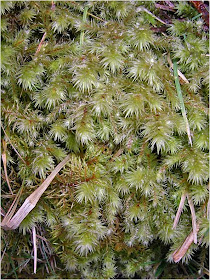Today's Guardian Country Diary focuses on mosses, which continue to grow in winter - even when most of the other vegetation in the countryside is dormant. This is really their season, when there's plenty of water, little shading from taller plants or woodland leaf canopies and when - on milder days - they can make rapid growth.
With little else in the plant world to explore at the moment, this is a good time to appreciate these durable little plants which were amongst the first to colonise the land surface and have survived as a group for half a billion years.
These are a few species from my neck of the woods....
Thuidium tamariscinum (Common Tamarisk Moss), growing in woodland
Plagiomnium undulatum (Hart's tongue Thyme-moss), another woodland species
Homalothecium sericeum, Silky Wall Feather moss, common on shaded tops of dry stone walls
Fissidens bryoides, Lesser Pocket-moss, often found on clay soils on ditch banks
Rhytidiadelphus triquetrus, Big Shaggy-moss, on a woodland edge
Hypnum cupressiforme,Cypress-leaved Plait-moss, with spore capsules, often on tree branches and rotting logs
Hypnum cupressiforme,Cypress-leaved Plait-moss - the leaves are curved inwards so the shoots look as though they're plaited.
Plagiomnium affine, Many-fruited Thyme-moss, has unusually large leaves. Growing here on the shady banks of an beck running through Hamsterley Forest.
Polytrichum commune,Common Haircap, growing in a wet hollow on open moorland.
Rhytidiadelphus squarrosus, Springy-turf moss, often in poorly drained grassland
Pseudoscleropodium purum, Neat Feather-moss, grows in grassland and has stout shoots that look as though they've been inflated.
Sphagnum sp., Bog moss, which forms peat bogs
Syntrichia ruralis subsp. ruraliformis, Sand-hill Screw-moss, forms extensive mats on the surface of sand dunes between Warkworth and Alnmouth on the Northumberland coast.
The Mosses and Liverworts of Britain and Ireland: a Field Guide, published by the British Bryological Society is an excellent guide to identifying our moss flora.
For more mosses, click here





















































